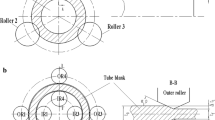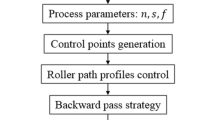Abstract
Multi-pass conventional spinning is the preferable forming technology for the forming of thin-walled conical part with curved surface (TCPCS) in aerospace field. In multi-pass conventional spinning, the design of roller path is a critical problem due to its sensitive effect on the deformation mode and forming defect during spinning process. However, at present, the roller path is still mainly designed based on experience and trial and error, which seriously restricts the high-performance spinning of TCPCS. In this work, a new quantitative method based on circumferential strain distribution was developed for the roller path design in multi-pass conventional spinning of TCPCS. In this method, the total required circumferential strain for the forming of final TCPCS by conventional spinning was firstly determined. Then, the spinning passes number was obtained through dividing the total required circumferential strain by the ultimate circumferential strain producing the spinning instability. As for the roller path profile in each pass, it is divided into two sections and determined, respectively, i.e., the attaching mandrel section and the preforming section. The attaching mandrel section presents the same profile of mandrel. The profile of preforming section is determined point by point by distributing the rest of circumferential strain to produce the final TCPCS. The point-by-point distributed circumferential strain is half of the the total required circumferential strain in the initial stage until it reaches the half of the ultimate circumferential strain, and then, it will keep the half of the ultimate circumferential strain to the end. The proposed new method of roller path design was validated by finite element simulation, where well spinning stability, wall thickness distribution and roundness were obtained. This method provides a quantitative, high-efficient and universal way for the roller path design in conventional spinning of TCPCS.












Similar content being viewed by others
References
Lin YC, Deng J, Jiang YQ, Wen DX, Liu G (2014) Hot tensile deformation behaviors and fracture characteristics of a typical Ni-based superalloy. Mater Des 55:949–957. https://doi.org/10.1016/j.matdes.2013.10.071
Gao PF, Yan XG, Li FG, Zhan M, Ma F, Fu MW (2022) Deformation mode and wall thickness variation in conventional spinning of metal sheets. Int J Mach Tool Manuf 173:103846. https://doi.org/10.1016/j.ijmachtools.2021.103846
Gao P, Yu C, Fu M, Xing L, Zhan M, Guo J (2021) Formability enhancement in hot spinning of titanium alloy thin-walled tube via prediction and control of ductile fracture. Chinese J Aeronaut. https://doi.org/10.1016/j.cja.2021.01.002
Chen SW, Gao PF, Zhan M, Ma F, Zhang HR, Xu RQ (2019) Determination of formability considering wrinkling defect in first-pass conventional spinning with linear roller path. J Mater Process Tech 265:44–55. https://doi.org/10.1016/j.jmatprotec.2018.10.003
Wei ZC, Li WD, Wan M, Xu CX, Liu J (2010) Influence of roller-trace on multi-pass conventional spinning process. J Plast Eng 17(3):108–112
Music O, Allwood JM, Kawai K (2010) A review of the mechanics of metal spinning. J Mater Process Tech 210:3–23. https://doi.org/10.1016/j.jmatprotec.2009.08.021
Xiao Y, Han Z, Zhou SY, Jia Z (2020) Experimental study of asymmetric multi-pass spinning. Int J Adv Manuf Technol 110:667–679. https://doi.org/10.1007/s00170-020-05913-7
Liu JH, Yang H (2003) Development of multi-process conventional spinning and research on roller-trace. Mech Sci Technol 22(5):805–807
Liu JH, Yang H, Li YQ (2002) A study of the stress and strain distributions of first-pass conventional spinning under different roller-traces. J Mater Process Tech 129:326–329. https://doi.org/10.1016/S0924-0136(02)00682-9
Hayama M, Kudo H, Shinokura T (2008) Study of the pass schedule in conventional simple spinning. Bull JSME 73:1358–1365. https://doi.org/10.1299/jsme1958.13.1358
Wang L, Long H (2011) A study of effects of roller path profiles on tool forces and part wall thickness variation in conventional metal spinning. J Mater Process Tech 211:2140–2151. https://doi.org/10.1016/j.jmatprotec.2011.07.013
James A, Polyblank JMA (2015) Parametric toolpath design in metal spinning. CIRP ANN-Manuf Technol 64(1):301–304. https://doi.org/10.1016/j.cirp.2015.04.077
Chen J, Wan M, Li WD (2008) Design of the involute trace of multi-pass conventional spinning and application in numerical simulation. J Plast Eng 015:53–57
Liu X, Zhang Y (1997) How to select the moving passes of the spinning roller. J Plast Eng 18:84–90
Guo H, Wang J, Lu G, Sang Z (2017) A study of multi-pass scheduling methods for die-less spinning. J Zhejiang Univ Sci A 18:413–429. https://doi.org/10.1631/jzus.A1600403
Gao L, Song J, Zhao Y, Yu Z (2021) Parametric roller path design in multi-pass conventional spinning of curvilinear generatrix parts. Int J Adv Manuf Technol 113:1637–1648. https://doi.org/10.1007/s00170-020-06556-4
Huang Y, Lu B, Chen J (2017) A parametric tool path design in muti -pass asymmetric spinning. J Shang Hai Jiao Tong Univ 51:1328–1333
Wang L, Long H (2011) Investigation of material deformation in multi-pass conventional metal spinning. Mater Des 32:2891–2899. https://doi.org/10.1016/j.matdes.2010.12.021
Zhang J, Zhan M, Yang H, Jiang Z, Han D (2012) 3D-FE modeling for power spinning of large ellipsoidal heads with variable thicknesses. Comput Mater Sci 53:303–313. https://doi.org/10.1016/j.commatsci.2011.08.010
Wang L, Long H (2013) Roller path design by tool compensation in multi-pass conventional spinning. Mater Des 46:645–653. https://doi.org/10.1016/j.matdes.2012.10.048
Zhan M, Gao PF (2022) Conventional spinning of sheet metals for fabrication of metallic parts and structures 197–213. https://doi.org/10.1016/B978-0-12-819726-4.00019-3
Acknowledgements
This study is supported by National Natural Science Foundation of China (No. 92060107, No. U1737212) and National Major Science and Technology Projects of China (J2019-VII-0014-0154).
Author information
Authors and Affiliations
Contributions
Yongdi Wang conceived the method and wrote the manuscript. Pengfei Gao directed and improved the method and put forward valuable suggestions for the writing of the article. Mei Zhan and Hongwei Li participated in article revision and provided project support. The contributions of Xinggang Yan and Haotong Niu lay in the discussion of previous methods and the inspection of manuscript, respectively. All authors discussed the results and commented on the manuscript.
Corresponding author
Ethics declarations
Ethical approval
Not applicable.
Consent to participate
Not applicable.
Consent for publication
All authors have read and agreed to the published version of the manuscript.
Competing interests
The authors declare no competing interests.
Additional information
Publisher's note
Springer Nature remains neutral with regard to jurisdictional claims in published maps and institutional affiliations.
Rights and permissions
About this article
Cite this article
Wang, Y., Li, H., Gao, P. et al. A method based on circumferential strain distribution for roller path design in conventional spinning of thin-walled conical part with curved surface. Int J Adv Manuf Technol 119, 4509–4518 (2022). https://doi.org/10.1007/s00170-022-08661-y
Received:
Accepted:
Published:
Issue Date:
DOI: https://doi.org/10.1007/s00170-022-08661-y




